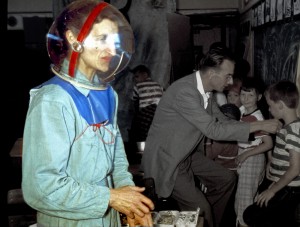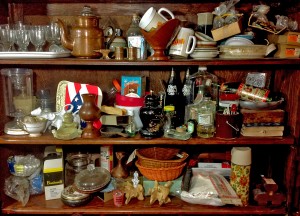
So last week we found ourselves renting an AirBNB room in an elderly three story house in Ithaca, NY owned by a couple in their 30s. Other inhabitants included a pair of large painted turtles in an indoor pond and a white bull terrier sporting a dark grey waistcoat snoozing on the couch in front of the fireplace. A windup Victrola stood to one side of the room, waiting to be fed from a couple of wooden boxes crammed with 78s. Alexis welcomed us with an easy smile and gave us short tour of the amenities.
All of the above would have been easily enough to make me feel completely comfortable and happy to be there. But as I scanned the room, trying to pick up details and clues about the lives and interests of the owners, I pretty much fell into a huge bookcase taking up most of one side of the room. It’s the kind of a bookcase you can’t take in standing in just one place. You have to walk back and forth, bending way over to the floor and standing on you tiptoes. You can feel the sheer physical presence of the books, probably 700-800 pounds of them.
Real books tucked shoulder to shoulder in a stack of wooden cubes 7 feet tall and more than 12 feet wide. Hundreds of books shelved with slight but not obsessive order, the kind of arrangement that leads to lucky accidents of co-location, such as the Collected Writings of Carl Jung sandwiched between Katz’ The Art of Fermentation and I Like You by Amy Sedaris.
There’s a thrill and an art in trying to divine a person’s life story from the books they keep in their cases. The condition of the books says a lot, but the clusters of topic and genre, the range of publication dates, and even the placement on the shelves speaks…well…volumes. For example, abandoned interests and hobbies usually drift down and to the side.
But that’s not what I was doing here. I was finding dozens and dozens of titles from my own library in a stranger’s bookcase in Ithaca. There are obvious reasons for that, of course. People of similar sensibilities do travel parallel paths. Still the sense that a bit of this house literally overlapped with my own house through the bookcases gave me a spooky through-the-wardrobe sort of a feeling.
Pablo Neruda, Vonnegut, The Rise and Fall of the Third Reich, Charles Bukowski, Philip K. Dick, A History of God by Karen Armstrong, to name only a few.
Books I read many years ago, remembered fondly but will probably never read again, books I’ve been reading but not finished, books on my list to read, books I own, haven’t read, won’t ever read, but for one reason or another can’t bring myself to get rid of.
The next morning Mark and Alexis gave us a kombucha “mother” so I could begin brewing my own, and the address of a guy in Syracuse who fixes broken Victrola springs, the malady that afflicts our own family Victrola.
I’ve been away from my own bookcase in our house in NH for almost five months. Such a pleasure of connection and commonality to find a portion of that bookcase in an Ithaca living room.



